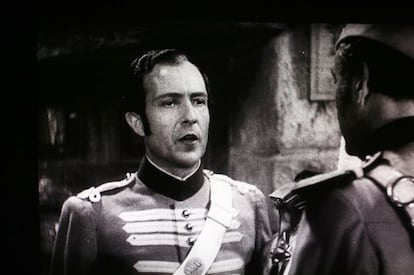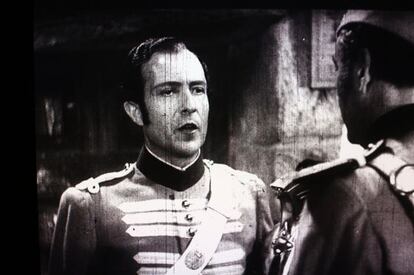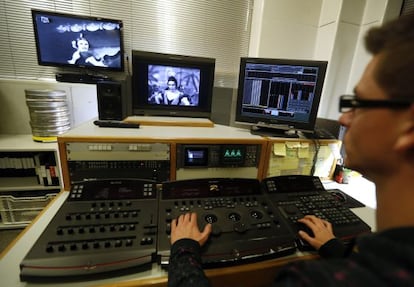The movies clean up their act
Producer Enrique Cerezo has restored 300 key titles from his enormous film catalogue Smartened-up works by Berlanga, Erice and Rossellini are all set for new Blu-ray and DVD releases

The face of actress Imperio Argentina looks clean and clear, free of the scratches and spots that had been distorting the images of Florián Rey’s 1938 movie Carmen la de Triana (Carmen, the girl from Triana). You can also hear her voice singing Los Piconeros loudly and clearly, with none of the background noise you normally find on old movies. A legendary song and a legendary star in the history of Spanish cinema, who 60 years later served as the model for Penélope Cruz’s character in Fernando Trueba’s The Girl of Your Dreams.
Over on another screen some neighbors wave farewell in a small-town port, white hankies in hand. They’ve stopped moving up and down, and the image has been stabilized. They are all residents of Peñiscola who performed as extras in Luis García Berlanga’s traditional and sentimental comedy Calabuch (1955).
One of the biggest projects ever mounted to save Spain’s cinematic heritage is returning a number of lost or damaged titles to their original glory in high definition. The man behind it is Enrique Cerezo, the president of Mercury Films (not to mention Atlético Madrid soccer club) and owner of one of the biggest film catalogues in Europe. In total he manages the rights of 7,000 titles, of which over half are Spanish productions, another 2,500 are Italian gems, and the rest are of other nationalities. “The problem is not buying them, the difficult thing is restoring all these films, some of which are in a regrettable state and not even their original negatives have been preserved,” says Cerezo in the laboratory where the restoration work is being carried out.

He first started buying the titles back in the 1980s when he purchased Cesáreo González and Benito Perojo’s production company and continued with the complete catalogues of Alta Films, Lola Films, Elía Querejeta, Sogepaq and Sogecine and director José Luis Borau’s Imán Producciones.
As a result, the most popular titles of Spanish stars Marisol and Joselito, the films of Víctor Erice and Alejandro Amenábar, Italian spaghetti westerns, along with black-and-white works directed by Vittorio de Sica and Rossellini will all be seeing the light in new high definition versions on Blu-ray and DVD. At the moment there are 300 titles set to go on sale from next week onwards priced between 9.95 and 11.95 euros for the DVDs and 14 and 18 for the Blu-ray discs.
Eric and Amenábar both wanted to be present to supervise their films in person, keeping an eye on the light, color and details. Erice, for instance, refused to let them remove the grain from The Spirit of the Beehive and Amenábar wanted the chance to erase the one woman who sneaked into the frame when he filmed Eduardo Noriega walking down an empty Gran Vía in Madrid in Open Your Eyes.

“They were here and they enjoyed restoring their films,” admits Carlos López, who headed up the team of 15 people who, with a mix of state-of-the-art technology and careful craftsmanship, went through frame by frame, scene by scene, removing all the dirt, spots and scratches. “Filmic heritage has not been looked after here. Only the Filmoteca film archive has done significant work,” Cerezo says.
Of the two films occupying the restorers in the laboratory in recent days, Calabuch is being restored from the original negative, but not a single original negative remains of Carmen la de Triana and the work is being done from an internegative copy. But whether they are originals or not, the first step to be taken in restoring a roll of 35 or 16 millimeter film is to pass it through a machine that, over two or three hours, gives it a proper clean with a product smelling strongly of alcohol. Once the worst of the dirt has been eliminated, it is passed through a drier and taken to a huge machine known as the Telecine, which is responsible for converting the film into high-definition video and performing a second clean to remove the first defects. The final phase is carried out in the restoration room where, frame by frame, a technician carefully removes the last remaining spots, scratches and defects by hand with a state-of-the-art machine, the first of its kind to be installed in Europe.
Tu suscripción se está usando en otro dispositivo
¿Quieres añadir otro usuario a tu suscripción?
Si continúas leyendo en este dispositivo, no se podrá leer en el otro.
FlechaTu suscripción se está usando en otro dispositivo y solo puedes acceder a EL PAÍS desde un dispositivo a la vez.
Si quieres compartir tu cuenta, cambia tu suscripción a la modalidad Premium, así podrás añadir otro usuario. Cada uno accederá con su propia cuenta de email, lo que os permitirá personalizar vuestra experiencia en EL PAÍS.
¿Tienes una suscripción de empresa? Accede aquí para contratar más cuentas.
En el caso de no saber quién está usando tu cuenta, te recomendamos cambiar tu contraseña aquí.
Si decides continuar compartiendo tu cuenta, este mensaje se mostrará en tu dispositivo y en el de la otra persona que está usando tu cuenta de forma indefinida, afectando a tu experiencia de lectura. Puedes consultar aquí los términos y condiciones de la suscripción digital.
Últimas noticias
Pinochet’s victims grapple with José Antonio Kast’s rise in Chile
Reinhard Genzel, Nobel laureate in physics: ‘One-minute videos will never give you the truth’
From digital curfews to blocking apps: How technology experts protect their children online
Why the price of coffee has skyrocketed: from Brazilian plantations to specialty coffee houses
Most viewed
- Why we lost the habit of sleeping in two segments and how that changed our sense of time
- Pablo Escobar’s hippos: A serious environmental problem, 40 years on
- Trump’s obsession with putting his name on everything is unprecedented in the United States
- The Florida Keys tourist paradise is besieged by immigration agents: ‘We’ve never seen anything like this’
- Charles Dubouloz, mountaineering star, retires at 36 with a farewell tour inspired by Walter Bonatti









































